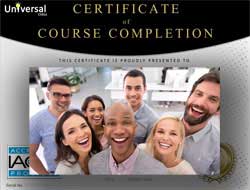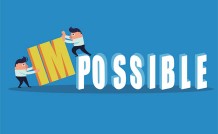Online Class: Decision Making Skills

no certificate
with CEU Certificate*
-
14Lessons
-
24Exams &
Assignments -
1,655Students
have taken this course -
8Hours
average time -
0.8CEUs
Course Description
The decision-making process is choosing among two or more courses of action for a given situation. Making decisions is a part of everyday life. Some consider it an art, others a proficiency. Decisions may be personal or professional, but, in each case, the choices will often have lasting consequences. In other words, the decisions we make have the potential to affect ourselves and others in the short and long term. Therefore, it is valuable to possess a skill set that will allow you to reflect and weigh alternatives -- finally electing the option that is the most appropriate for each situation.
Experts and laymen, alike, have offered a wealth of suggestions about how to become an accomplished decision maker. Some advocate an elementary approach, such as creating a mental checklist that is habitually referred to when the individual is faced with choices. Others prefer to implement a much more highly complex set of procedures that should end in optimal results. In this online course, both concepts will be incorporated. In other words, the goal is to maximize the amount of knowledge the learner is given about each component of the course, without overwhelming the individual. In this case, the decision-making process will be separated into four steps, with explanations of how they can be applied in formal and informal situations. This will allow the reader to internalize the process of decision making, while developing an understanding of its application in diverse settings.
Step 1 – Identify the Goal or Problem that Requires a Decision
The first step in the decision-making process is to identify the decision that an individual is facing. The problem may be simple enough to explain with basic language, and that will not ultimately require hours of reflection, such as, "The babysitter didn't show up today and I have to go to work, so now what do I do?" However, this very same challenge might be stated in more eloquent and exaggerated language, such as, "I am required to be on the job site today and our in-home child care worker has failed to appear at our agreed-upon time. It is possible she has decided not to continue her employment with us, and now I must decide how to move forward with this conundrum, both immediately, and long term."
Also, decision making is not always associated with a problem, but can also take the form of goal-setting. For instance, a person may be thinking about their future and say to themselves, "Going to college is probably a good option, if I want to make a lot of money in the future." The aim is apparent, although perhaps addressed somewhat artlessly. Another way this same goal can be clarified might be with more sophisticated verbiage such as, "I am faced with the decision of attending college and postponing employment, or finding a job and joining the workforce immediately. These are choices that require greater investigation." Ultimately, no matter how the problem or goal is identified, the most important point is the essence of the first step in the decision-making process -- to be able to state the problem in plain and understandable verbiage.
Step 2 – Gather Information and Alternatives Associated With Choices
With a clear idea in mind of the decision that a person is facing, the next step is to brainstorm or research all of the possible options. This, too, depends on the seriousness of the challenge faced, and how quickly the decision must be made. If we return to the first example in Step 1, we find a parent who may be moments away from expecting to leave his or her home and head to work, safe in the routine of the caregiver's arrival. Instead, with the chance that the parent is left to fend for themselves at the last minute, he or she is likely to run through a mental list of choices to alleviate the immediate problem, and address it long-term in the following hours or days. Perhaps the parent has family or neighbors to whom they could turn for last-minute babysitting. Another option might be to contact their place of employment and explain the situation, remaining at home and looking for immediate childcare alternatives. No matter what choice the parent makes, they are clearly at Step 2 in the decision-making process -- listing all the possible options and solutions that are available, no matter how extreme they may first appear. In the case of the life choice regarding college attendance, this is a decision that will require greater thought and research. Relevant information will need to be gathered prior to a determination. It is important to remember that this step also includes seeking the advice of experts in the field, and the opinions of trusted family members or associates. Their expertise may provide the decision-maker with real-world and relevant insight that would further advance the process.
Finally, information-gathering will result in the identification of alternatives for each preference, along with the degree to which the choice is viable or desirable. It is important to incorporate these findings into the information-gathering step. By this, what is meant is that your investigation into choices should include acknowledgment of consequences that might affect the pursuit of a particular option, and/or its outcome, or the "good and bad" outcomes that can result from the pursuit of each option. For example, when deciding whether or not to attend college, one of the repercussions of pursuing an advanced education could be that the individual must live with his or her parents, until the degree is complete. This might make the choice less palatable, but should be confirmed as an authentic fallout in Step 2 of the decision-making process.
Step 3 – Make Your Decision
Once the alternatives have been explored extensively, and a list of choices has been generated from which an optimal decision can be made, the natural next step is to actually elect one of the options that have been developed. Now, selecting the best possible solution is also not as easy as it may sound. However, if you have put in the effort to state the problem clearly and investigate your options, then the actual process of deciding on an alternative will be simpler, and you will be able to move forward with greater confidence. Sometimes, when an individual reaches this point of the decision-making process, the best choice from among the opportunities might be evident and stand out from among the rest. For example, in the case of the mother who has last-minute babysitting issues, if all of the choices she can brainstorm include leaving the children with family members, asking a neighbor to watch them, or staying home herself, the first two options might seem salient. But if there are no neighbors or family nearby with whom the person could entrust her children to, then it is obvious she has no choice, but to stay home with the children.
However, in the instance where a young person is mulling over the pros and cons of college attendance, a variety of choices may arise. Perhaps they could attend college part-time and work part-time; or maybe the individual could attend a less expensive university, freeing up some cash for moving out of the home. Here, there is a broader spectrum of choices, and, therefore, the implications for decision making are more challenging. Even so, this is the point where a preference must be indicated. It is also the time in the decision-making process that can cause the most stress. It requires personal insight, a level of gut instinct, and a leap of faith -- all at the same time. If the decision-maker has put in the adequate amount of effort, then this will allow the individual to select the appropriate option with greater confidence.
If possible, it is recommended that even after a decision has been made, the person faced with the task take some time to reflect on their choice over the course of several days, asking themselves such questions as, "How do I feel, now that I have opted for this direction," or, "What is my comfort level, now that I have made this choice from the options I listed?" Now, it might be a good idea to let your subconscious do the thinking for you. In other words, you have actively implemented the decision-making process to this point. You have named your problem, you have considered all of the choices you have available, and you have made a reasoned decision based on the information you collected. Now, trust yourself to internalize the decision and listen to your inner voice -– whether or not it is telling you that the choice is the right one for your future, or if there are still some misgivings about the decision.
Step 4 - Put Your Decision into Action and Evaluate
It is not uncommon for people to put off decision-making because they are hesitant to make life-defining choices. Yet this is part of growing up and becoming an adult, and each time a person implements the decision-making process, he or she becomes more adept and competent in the skill, and more confident of their own ability to utilize it for their own benefit. In other words, taking action is the adult part of the decision-making process and the end result of all the pre-planning that goes into it. No matter what decision you are faced with making, you eventually have to act on it. There is an exhilarating feeling that comes with action, particularly if it is based on the proper application of the decision-making process.
If we use the two examples from this section, we find that the parent has decided to stay home and spend the time finding a quality daycare replacement. In this case, it is the father, and he is spending the morning contacting nursery schools in the area and setting up visitations for the following day. He and his wife have agreed to take turns staying home with the children over the next few days until a proper solution can be found. The individual who is trying to decide whether or not to attend college has come to the conclusion that he will need an advanced education if he is going to be able to enter environmental work. He does have limited funds, however, and does not want to live at home. So he has enrolled in a nearby community college, found gainful full-time employment, and is moving into an efficiency apartment near the school.
Conclusions and Review
The decision-makers in both instances are satisfied with their choices, and even more content with their ability to manipulate the decision-making process to their advantage. Over the next few weeks and months, they will review the choices they have made to determine if they were the best options for their situations, and whether or not the plan needs to be "tweaked" in some way. Either way, this application of the decision-making process has advanced their expertise in the four steps that are required to navigate life's choices.
If you are venturing into this online course of study to become more adept, if not expert, in decision making, then it is valuable to remember the four steps of the process. First, state the problem in clear and plain language. Second, research all of the options that are available to address the problem. Third, make the choice from the alternatives considered. Fourth, enact the decision and evaluate to ensure that it is the correct one to meet its stated purpose. Remember, practice makes perfect, and this is especially true of decision-making.
- Completely Online
- Self-Paced
- Printable Lessons
- Full HD Video

- 6 Months to Complete
- 24/7 Availability
- Start Anytime
- PC & Mac Compatible
- Android & iOS Friendly
- Accredited CEUs

Course Lessons
Lesson 1: Decision-Making Process
 Lesson 1 Video
Lesson 1 Video Lesson discussions: Reasons for Taking this Course
Lesson discussions: Reasons for Taking this Course Complete Assignment: An Introduction
Complete Assignment: An Introduction Assessment: Exam 1
Assessment: Exam 1
Lesson 2: Anatomy of a Decision
 Lesson 2 Video
Lesson 2 Video Complete Assignment: Anatomy of a Decision
Complete Assignment: Anatomy of a Decision Assessment: Exam 2
Assessment: Exam 2
Lesson 3: How to Use Problem Solving Steps and Problem Solving Tools
 Lesson 3 Video
Lesson 3 Video Assessment: Exam 3
Assessment: Exam 3
Lesson 4: Distinguish Root Causes From Symptoms to Identify the Right Solution for the Right Problem.
 Lesson 4 Video
Lesson 4 Video Complete Assignment: The Steps for Distinguishing the Root Causes
Complete Assignment: The Steps for Distinguishing the Root Causes Assessment: Exam 4
Assessment: Exam 4
Lesson 5: Identifying Individual Problem-Solving Styles
 Lesson 5 Video
Lesson 5 Video Complete: Lesson 5 Assignment
Complete: Lesson 5 Assignment Assessment: Exam 5
Assessment: Exam 5
Lesson 6: The Creative Process for Making Decisions
 Lesson 6 Video
Lesson 6 Video Assessment: Exam 6
Assessment: Exam 6
Lesson 7: Barriers to Creativity & Overcoming Them, Part I
 Lesson 7 Video
Lesson 7 Video Assessment: Exam 7
Assessment: Exam 7
Lesson 8: Barriers to Creativity & Overcoming Them, Part II
 Lesson 8 Video
Lesson 8 Video Assessment: Exam 8
Assessment: Exam 8
Lesson 9: Tools to Improve Creativity
 Lesson 9 Video
Lesson 9 Video Complete: Lesson 9 Assignment
Complete: Lesson 9 Assignment  Assessment: Exam 9
Assessment: Exam 9
Lesson 10: The Analytical Process in Decision Making
 Lesson 10 Video
Lesson 10 Video Assessment: Exam 10
Assessment: Exam 10
Lesson 11: Tools to Improve Analysis
 Lesson 11 Video
Lesson 11 Video Complete: Lesson 11 Assignment
Complete: Lesson 11 Assignment Assessment: Exam 11
Assessment: Exam 11
Lesson 12: Irrational Factors and Emotions That Affect Decision Making
 Lesson 12 Video
Lesson 12 Video Complete Assignment: Emotional Decision Making
Complete Assignment: Emotional Decision Making Assessment: Exam 12
Assessment: Exam 12
Lesson 13: Fifteen Rules for Decision Making
 Lesson 13 Video
Lesson 13 Video Complete: Lesson 13 Assignment
Complete: Lesson 13 Assignment Assessment: Exam 13
Assessment: Exam 13
Lesson 14: Implementing the Decision -- Wrap Up
 Lesson 14 Video
Lesson 14 Video Lesson discussions: End of Course Poll; Course Comments; Program Evaluation Follow-up Survey (End of Course)
Lesson discussions: End of Course Poll; Course Comments; Program Evaluation Follow-up Survey (End of Course) Complete Assignment: Implementing a Decision
Complete Assignment: Implementing a Decision Assessment: Exam 14
Assessment: Exam 14 Assessment: The Final Exam
Assessment: The Final Exam
Learning Outcomes
- Define the decision-making process.
- Describe the anatomy of a decision.
- Summarize how to use problem solving steps and problem solving tools.
- Identify root causes, symptoms, and solutions for problems.
- Identify individual problem-solving styles.
- Determine your barriers to creativity and how to overcome them.
- Describe the tools to improve creativity.
- Describe the analytical process in decision making.
- Identify tools to improve analysis.
- Recognize irrational factors and emotions that affect decision making.
- Summarize the fifteen rules for decision making.
- Identify ways to effectively implement a decision.
- Demonstrate mastery of lesson content at levels of 70% or higher.
Additional Course Information

- Document Your Lifelong Learning Achievements
- Earn an Official Certificate Documenting Course Hours and CEUs
- Verify Your Certificate with a Unique Serial Number Online
- View and Share Your Certificate Online or Download/Print as PDF
- Display Your Certificate on Your Resume and Promote Your Achievements Using Social Media

Choose Your Subscription Plan
No Certificate / No CEUs
This course only
| Includes certificate | X |
| Includes CEUs | X |
| Self-paced |

|
| Instructor support |

|
| Time to complete | 6 months |
| No. of courses | 1 course |
Certificate & CEUs
This course only
| Includes certificate |

|
| Includes CEUs |

|
| Self-paced |

|
| Instructor support |

|
| Time to complete | 6 months |
| No. of courses | 1 course |
Certificates & CEUs
Includes all 600+ courses
| Includes certificate |

|
| Includes CEUs |

|
| Self-paced |

|
| Instructor support |

|
| Time to complete | 12 Months |
| No. of courses | 600+ |
Certificates & CEUs
Includes all 600+ courses
| Includes certificate |

|
| Includes CEUs |

|
| Self-paced |

|
| Instructor support |

|
| Time to complete | 24 Months |
| No. of courses | 600+ |
Student Testimonials
- "This course was extremely useful in assisting me to improve my decision-making skills. I found the instructor to be thoughtful and helpful in his comments at the end of each assignment." -- Geraldine H.
- "Quiet frankly, I have not done this course before in my life. Decision making course are a very helpful tool to utilize personally or professionally. After studying it online, I think I should be able to implement creative and analytic ideas before finally make a critical decision whether at home or in my workplace. I really enjoyed studying this course online." -- Waisea T.
- "Really good course, overall I appreciated all content." -- Leanne B.
- "I LOVED IT. It was extremely in-depth and helpful." -- Cesar P.
- "Thank you for the great class!" -- Dominick H.
Related Courses
-
 36 hours
3.6 CEUs
Ultimate Secretary Training Bundle
$150.00
36 hours
3.6 CEUs
Ultimate Secretary Training Bundle
$150.00
-
 29 hours
2.9 CEUs
Human Resources Productivity Course Bundle
$120.00
29 hours
2.9 CEUs
Human Resources Productivity Course Bundle
$120.00
-
 7 hours
0.7 CEUs
Introduction to Logic
$95.00
7 hours
0.7 CEUs
Introduction to Logic
$95.00
-
 5 hours
0.5 CEUs
Developing Great Social Skills
$95.00
5 hours
0.5 CEUs
Developing Great Social Skills
$95.00
-
 5 hours
0.5 CEUs
Lawful Employee Termination
$95.00
5 hours
0.5 CEUs
Lawful Employee Termination
$95.00
-
 7 hours
0.7 CEUs
Preventing Workplace Harassment
$95.00
7 hours
0.7 CEUs
Preventing Workplace Harassment
$95.00
-
 5 hours
0.5 CEUs
Emotional Intelligence
$95.00
5 hours
0.5 CEUs
Emotional Intelligence
$95.00
-
 5 hours
0.5 CEUs
Habits of Millionaires
$95.00
5 hours
0.5 CEUs
Habits of Millionaires
$95.00
-
 6 hours
0.6 CEUs
Mindfulness in the Workplace
$95.00
6 hours
0.6 CEUs
Mindfulness in the Workplace
$95.00
-
 6 hours
0.6 CEUs
Gender Sensitivity Training
$95.00
6 hours
0.6 CEUs
Gender Sensitivity Training
$95.00
-
 8 hours
0.8 CEUs
Procurement Management
$95.00
8 hours
0.8 CEUs
Procurement Management
$95.00
-
 6 hours
0.6 CEUs
Goal Setting for Business
$95.00
6 hours
0.6 CEUs
Goal Setting for Business
$95.00
-
 6 hours
0.6 CEUs
Fair Standards Labor Act and the Workforce
$95.00
6 hours
0.6 CEUs
Fair Standards Labor Act and the Workforce
$95.00
-
 15 hours
1.5 CEUs
Customer Service 101
$95.00
15 hours
1.5 CEUs
Customer Service 101
$95.00
-
 14 hours
1.4 CEUs
Report Writing 101
$95.00
14 hours
1.4 CEUs
Report Writing 101
$95.00
-
 7 hours
0.7 CEUs
How to Win Arguments
$95.00
7 hours
0.7 CEUs
How to Win Arguments
$95.00
-
 8 hours
0.8 CEUs
Community Development 101
$95.00
8 hours
0.8 CEUs
Community Development 101
$95.00
-
 7 hours
0.7 CEUs
Organizational Behavior in Business
$95.00
7 hours
0.7 CEUs
Organizational Behavior in Business
$95.00
-
 7 hours
0.7 CEUs
Leadership Skills for Managers
$95.00
7 hours
0.7 CEUs
Leadership Skills for Managers
$95.00
-
 9 hours
0.9 CEUs
Product Management 101
$95.00
9 hours
0.9 CEUs
Product Management 101
$95.00
-
 7 hours
0.7 CEUs
Lean Management
$95.00
7 hours
0.7 CEUs
Lean Management
$95.00
-
 6 hours
0.6 CEUs
Business Branding 101
$95.00
6 hours
0.6 CEUs
Business Branding 101
$95.00
-
 7 hours
0.7 CEUs
Collaboration Skills
$95.00
7 hours
0.7 CEUs
Collaboration Skills
$95.00
-
 6 hours
0.6 CEUs
Personal Assistant 101
$95.00
6 hours
0.6 CEUs
Personal Assistant 101
$95.00
-
 7 hours
0.7 CEUs
Respectful International Workplace
$95.00
7 hours
0.7 CEUs
Respectful International Workplace
$95.00
-
 4 hours
0.4 CEUs
Resolving Workplace Conflict
$95.00
4 hours
0.4 CEUs
Resolving Workplace Conflict
$95.00
-
 6 hours
0.6 CEUs
Delegation Skills
$95.00
6 hours
0.6 CEUs
Delegation Skills
$95.00
-
 7 hours
0.7 CEUs
Sensitivity Training for the Workplace
$95.00
7 hours
0.7 CEUs
Sensitivity Training for the Workplace
$95.00
-
 5 hours
0.5 CEUs
Team Building 101
$95.00
5 hours
0.5 CEUs
Team Building 101
$95.00
-
 8 hours
0.8 CEUs
Motivational and Public Speaking 101
$95.00
8 hours
0.8 CEUs
Motivational and Public Speaking 101
$95.00
-
 7 hours
0.7 CEUs
Workplace Sexual Harassment in the #MeToo Era
$95.00
7 hours
0.7 CEUs
Workplace Sexual Harassment in the #MeToo Era
$95.00
-
 7 hours
0.7 CEUs
Management Consultant 101
$95.00
7 hours
0.7 CEUs
Management Consultant 101
$95.00
-
 6 hours
0.6 CEUs
Management Essentials
$95.00
6 hours
0.6 CEUs
Management Essentials
$95.00
-
 9 hours
0.9 CEUs
Introduction to Six Sigma
$95.00
9 hours
0.9 CEUs
Introduction to Six Sigma
$95.00
-
 7 hours
0.7 CEUs
Financial Analysis 101: Planning and Control
$95.00
7 hours
0.7 CEUs
Financial Analysis 101: Planning and Control
$95.00
-
 7 hours
0.7 CEUs
Innovative Thinking
$95.00
7 hours
0.7 CEUs
Innovative Thinking
$95.00
-
 7 hours
0.7 CEUs
Introduction to Ethics
$95.00
7 hours
0.7 CEUs
Introduction to Ethics
$95.00









